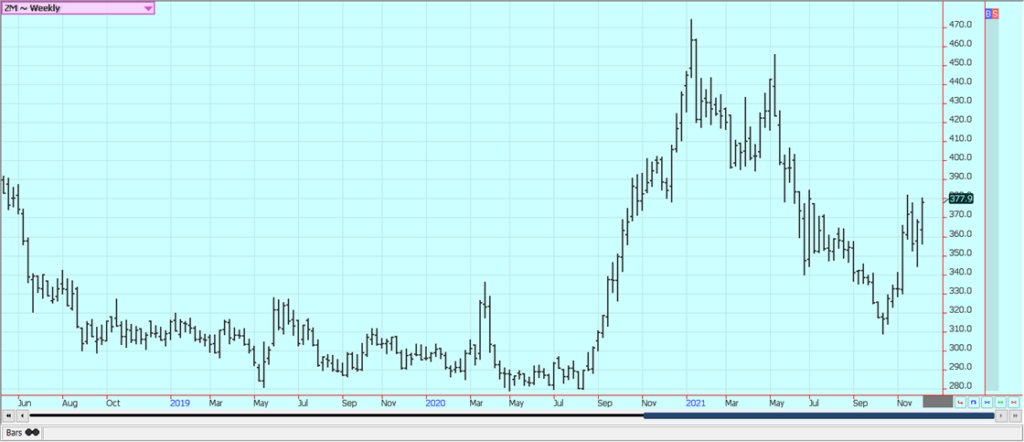Featured
Speculative Selling Influenced the Price of Rice Futures
Rice was slightly higher on Friday but lower for the week on what appeared to be speculative selling. USDA made only small changes to supply and demand in the latest WASDE estimates. Small changes were noted in the world estimates as well. Traders were preparing for the next round of WASDE reports that will be issued later today. Futures have held some important support areas on the daily and weekly charts but act weak.

Wheat: Wheat closed higher on Friday in recovery trading but lower for the week in part in response to the USDA reports that showed increased US and world ending stocks levels mostly through greater world production and somewhat reduced US export potential. US exports were reduced by 20 million bushels and imports were reduced by 5 million bushels for a net increase in ending stocks of 15 million bushels. The increase in world production came mostly from Australia and Russia. Central and southern parts of the Plains are expected to get a little rain and mild temperatures that would greatly aid in establishment. Trends are still sideways in all three markets. The market is talking about the buildup of Russian troops along the Ukraine border and fears a war will break out. A war between these two countries could have severe repercussions for world Wheat trade as both are big producers and exporters. Ideas have been that the US will have good demand for Wheat as the rest of the northern hemisphere is short production this year but so far demand has been average against previous years. Offer volumes are down from both Russia and Europe although there has been talk of increased offers from Russia. Dry weather in southern Russia as well as the northern US Great Plains and Canadian Prairies caused a lot less production and are still supporting the market. The lack of production has reduced the offers and Russia plans to announce sales quotas for next year very soon. Russia has already increased export taxes to control the flow of export Wheat out of the country. Australia has had too much rain and the crop quality should be diminished, but conditions are drier now and the harvest is moving ahead. These international moves should increase demand for US Wheat but this has not really happened yet.
Weekly Chicago Soft Red Winter Wheat Futures

Weekly Chicago Hard Red Winter Wheat Futures

Weekly Minneapolis Hard Red Spring Wheat Futures

Corn: Corn closed a little higher last week and trends are turning up on the daily and weekly charts. USDA made no changed to US supply and demand data but increased world production and ending stocks by a little bit. There had been some talk of reduced US demand so the fact that it was left unchanged was considered a little bullish. The weekly charts still suggest higher prices are coming longer term and the fundamentals do as well. Corn has relatively tight supplies as farmers are mostly done harvesting and not selling. Demand will be an increasing feature in the trade moving forward and Mexico was a huge buyer yesterday. Demand has been good so far this season but a lot of business has gone to Ukraine this Fall. That is expected to change over the Winter as Ukraine exportable supplies start to run low. It could change further is Russia invades Ukraine in the future. Interior basis levels are reported to be strong due to strong demand. There are a lot of ideas that production and planted and harvested area will be significantly less next year due to the lack of fertilizers available and the cost of production.
Weekly Corn Futures

Weekly Oats Futures

Soybeans and Soybean Meal: Soybeans were little changed last week while Soybean Meal closed higher and Soybean Oil closed lower and the trends are still mixed on the daily charts. USDA made no changes to its US supply and demand and ending stocks estimates. It also made no changes to South American production estimates. Soybean Oil closed lower despite the price action in competing oils and Crude Oil on news that the Biden administration had reduced renewable fuels blending requirements for refiners. Traders were preparing for the WASDE reports that will be released later today. Reports indicate that farmers are limited sellers at best. Planting and initial crop development is going very well in Brazil but it has turned dry in southern Brazil and Argentina and some weather-related support is coming to the futures market. Brazil could have soybeans ready for export by the end of February and the crop potential is up to 150 million tons.
Weekly Chicago Soybeans Futures:

Weekly Chicago Soybean Meal Futures

Rice: Rice was slightly higher on Friday but lower for the week on what appeared to be speculative selling. USDA made only small changes to supply and demand in the latest WASDE estimates. Small changes were noted in the world estimates as well. Traders were preparing for the next round of WASDE reports that will be issued later today. Futures have held some important support areas on the daily and weekly charts but act weak. Many producers are done harvesting and are hunting and not interested in selling at a time that is traditionally the cheapest prices of the year. The cash market is reported to be relatively strong.
Weekly Chicago Rice Futures

Palm Oil and Vegetable Oils: Palm Oil was higher last week. Improved export demand is reported but still faces headwinds due to the world wide Covid outbreak along with worries about demand. Futures are now at the lower end of the range. Reports of new lockdowns in Europe and a new variant of the Coronavirus discovered n Africa hurt demand ideas on Friday and caused speculative selling to reduce risk. Support still comes from ideas that supply and demand are in balance or supplies are short. There are ideas of tight supplies due to labor problems. There are just not enough workers in the fields due to Coronavirus restrictions. Production has also been down to more than offset the export losses so prices have trended higher. MPOB reported lower ending stocks in November than in October on Friday. Canola was lower last week along with price action in Chicago Soybean Oil and on the Coronavirus news and its potential effects on demand. Farmers are bullish and reluctant to sell because of the sharp reduction in Canola production in Canada this year. However, competing oils are down hard and Canola needed to fall as well. Soybean Oil was also lower as the Biden administration has cut some of the mandates for bio fuels blending in the US.
Weekly Malaysian Palm Oil Futures

Weekly Chicago Soybean Oil Futures

Weekly Canola Futures:

Cotton: Cotton futures closed lower on Friday and last week partly in response to the USDA WASDE estimates. USDA showed a slight increase in production estimates and unchanged demand and ending stocks estimates. The weekly export sales report was very strong. The new Covid variant is expected to spread quickly but produce mild reactions but the demand concerns are there as China might buy less now. Chart patterns are sideways. Demand has fallen off with the rally in the US Dollar but US prices are reported to be still well below those in China. Trends are starting to turn down on the weaker demand ideas. Analysts say the Asian demand is still very strong and likely hold at high levels for the future. US consumer demand has been very strong as well despite higher prices and inflation. Good US production is expected.
Weekly US Cotton Futures

Frozen Concentrated Orange Juice and Citrus: FCOJ was lower on Friday and trends are still sideways as futures remain locked in a range trade. USDA cut its Oranges production estimate but this was anticipated by the trade. Demand ideas were hurt here and around the world by the return of Covid induced lockdowns in Europe and the discovery of a new Covid variation in Africa. The variant seems to spread rapidly but produces mild effects so much of the concern has been lessened for now. The weather remains generally good for production around the world. Brazil has some rain with more in the forecast and flowering is likely. Brazil production was down last year due to dry conditions at flowering time and then a freeze just before harvest. Weather conditions in Florida are rated mostly good for the crops with a couple of showers and near normal temperatures. Mexican crop conditions in central and southern areas are called good with rains. Northern and western Mexico is rated in good condition. The Florida Citrus Movement and Pack report showed that inventories are still almost 16% below last year at this time.
Weekly FCOJ Futures

Coffee: New York closed lower and London closed mostly lower Friday on improved weather for Brazil Arabica areas and as the logistical and production problems in Brazil and Vietnam remain important. The big rains could have damage trees and caused flowers and cherries to fall. The lack of Coffee available to deliver against contracts remains a factor and the cheapest Coffee for buyers is often at the exchanges. Containers are not available in Vietnam or in Brazil to ship the Coffee. Cherry pickers are hard to find in Vietnam due to Covid problems. Covid has also returned to Vietnam and now the rest of the world and could be a factor in interrupting shipments. Brazil also has limited amounts of Coffee available after bad weather at flowering time and then a freeze before the harvest got underway. Production conditions for the next crop in Colombia are not real good. Scattered to isolated showers are now in the forecast for Southeast Asia and for Vietnam after big rains before.
Weekly New York Arabica Coffee Futures

Weekly London Robusta Coffee Futures

Sugar: New York and London closed a little higher on Friday in trading tied to stronger price action in world petroleum and financial markets. Weaker production ideas in Brazil have supported futures to a large degree. Weaker demand ideas were still being caused by reports of new lockdowns in Europe as the Covid returns there and reports of a new variant discovered in Africa. However, the effects of the new variant are reported to be mild so the fears were less. The daily charts show that trends are mostly up. Reports indicate that consumer demand has returned to the market but not in a big way. Ideas are that the supplies are out there but it will take a stronger price to get them into the market. Ideas are that Indian producers and exporters are willing sellers above 20.50 cents. Processors in Brazil are refining the cane for Ethanol more than Sugar right now and this trend is expected to continue due to the relative price spreads. The reduced production potential from Brazil for the current harvest is still impacting the market as cane production suffered last season. India is not offering as world prices are still below domestic prices.
Weekly New York World Raw Sugar Futures

Weekly London White Sugar Futures

Cocoa: New York closed higher and London closed lower on Friday as the US Dollar moved higher and certified stocks in New York moved lower. The return of the Coronavirus in Europe as well as the new variant found in Africa were the primary reasons to sell but are mostly part of the price now. Much of the selling came on ideas of weaker demand caused by the reports. Ideas are that demand will only improve slightly if at all and production in West Africa appears to be good this year. Both Ivory Coast and Ghana are reporting improved weather as it is now mostly sunny with some scattered showers around. Some farmers want more rain for the best Spring harvest results.
Weekly New York Cocoa Futures

Weekly London Cocoa Futures

—
(Featured image by oarranzli via Flickr)
DISCLAIMER: This article was written by a third party contributor and does not reflect the opinion of Born2Invest, its management, staff or its associates. Please review our disclaimer for more information.
This article may include forward-looking statements. These forward-looking statements generally are identified by the words “believe,” “project,” “estimate,” “become,” “plan,” “will,” and similar expressions. These forward-looking statements involve known and unknown risks as well as uncertainties, including those discussed in the following cautionary statements and elsewhere in this article and on this site. Although the Company may believe that its expectations are based on reasonable assumptions, the actual results that the Company may achieve may differ materially from any forward-looking statements, which reflect the opinions of the management of the Company only as of the date hereof. Additionally, please make sure to read these important disclosures.
Futures and options trading involves substantial risk of loss and may not be suitable for everyone. The valuation of futures and options may fluctuate and as a result, clients may lose more than their original investment. In no event should the content of this website be construed as an express or implied promise, guarantee, or implication by or from The PRICE Futures Group, Inc. that you will profit or that losses can or will be limited whatsoever. Past performance is not indicative of future results. Information provided on this report is intended solely for informative purpose and is obtained from sources believed to be reliable. No guarantee of any kind is implied or possible where projections of future conditions are attempted. The leverage created by trading on margin can work against you as well as for you, and losses can exceed your entire investment. Before opening an account and trading, you should seek advice from your advisors as appropriate to ensure that you understand the risks and can withstand the losses.

-

 Business2 weeks ago
Business2 weeks agoFed Holds Interest Rates Steady Amid Solid Economic Indicators
-

 Fintech1 week ago
Fintech1 week agoMuzinich and Nao Partner to Open Private Credit Fund to Retail Investors
-

 Crowdfunding2 weeks ago
Crowdfunding2 weeks agoSwitzerland’s Crowdfunding Market Remains Stable – Without Growth
-

 Crypto3 days ago
Crypto3 days agoBitcoin Traders on DEXs Brace for Downturn Despite Price Rally

























